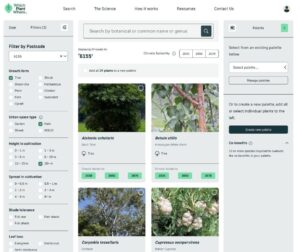
Which Plant Where: The right plant for the right place
By Samantha Newton
Our cities are increasingly challenged by expanding human population and climate change. Resilient urban green spaces are recognised as critical for the development and sustainability of liveable cities for the future, providing a range of ecosystem services and benefits. The Which Plant Where climate-ready plant selector tool is a web-based tool that helps people choose the right plants for Australian cities for the weather conditions of today and into the future. It offers a plant selection guide for growers, nurseries, landscape designers, councils, and anyone involved in urban greening. It is supported by strong scientific research on how well different plants can cope with changing climates, supporting the creation of greener, more sustainable cities.
Recent updates
In August, the Which Plant Where website was updated. It is now bigger and better with an additional 200 species, more plant traits and improved user experience, bringing the total number of species to 2,800. The extra species include a greater proportion of plants native to Western Australia (30%), Queensland (40%) and Northern Territory (20%), making it even more useful for tropical and western urban environments.
Additional plant characteristics
Responding to feedback and survey results we have also added 5 characteristics.
Tree lifespan
The lifespan classifications in Which Plant Where are an estimate of average Useful Life Expectancy (ULE) of tree species for trees in an urban or horticultural setting. Lifespan is classed as short (<10 years), moderate (10-50 years) or long (>50 years). These classes are deliberately broad, as individuals within the same species will perform differently depending on local conditions and level of disturbance.
Flammability
Plant flammability refers to how easily vegetation ignites and contributes to fire spread. We categorised plant flammability into three levels: low, moderate, and high. Low flammability species are most suitable for planting near houses and critical infrastructure. For example, native frangipani (Hymenosporum flavum) is a native shrub or tree with large, glossy leaves that has high moisture content and low levels of volatile oils compared to more flammable species.
Water use
In Which Plant Where, we define ‘water use’ as the relative amount of supplementary irrigation required to maintain a plant’s health and appearance over the lifetime of the plant. We have followed industry best practice examples for classifying species into categories of typical water use requirements. These categories are deliberately broad (low, moderate, high) because water use of individuals within a species can vary depending on the planting context. It is important to distinguish water use from drought tolerance, which is captured as a separate trait in the database.
Salinity tolerance
Salinity tolerance (none, low, moderate, high) refers to the ability of plants to withstand various concentrations of salt in the soil. The identification and use of salt-tolerant plant species has been important for restoration and revegetation of salt-affected landscapes. This information is also useful for creating resilient coastal gardens that can withstand salt spray, sandy soils and occasional seawater inundation.
Risk to infrastructure: Tree root attributes that could impact the built environment
Some trees and shrubs have attributes that may cause problems if they are planted inappropriately, i.e. in poorly selected sites or using poor planting techniques. In Which Plant Where, information is provided at the species-level that is relevant to tree root and infrastructure interactions, including suckering, shallow and aerial roots, or simply an indication that a plant has a vigorous root system that will need more space or distance from infrastructure.
Improved user experience
Several improvements were made to the search function and page layouts. The plant search page now allows you to search for botanical or common name in the same window. You can even search for genus if you are not sure which species you are looking for, or if you are unsure of the correct spelling. Improvements were also made to the plant palette tool. The palette tool allows users to gather co-benefits of shade, carbon, and biodiversity when a collection of 10 or more species is selected for a single postcode – great for landscape planning.
Adoption and extension
In addition to website improvement, the Which Plant Where project team has done extensive research into long-term investment and marketing needs for the project and plant selection tool.
The major findings of the research showed that the Which Plant Where tool is trusted as a credible source of information and is a leading tool that is used in plant selection decision-making across Australia. Which Plant Where is highly valued across industry and government with the greenlife industry very supportive of this tool, specifically its potential ability to connect plant selectors with plant suppliers and as a credible source of information that supports decision-making. The greenlife industry recognises the potential benefits that Which Plant Where can bring through providing information and direction on retail sector and landscape sector demand. The tool’s development also reflected well on the industry as a leading innovator for climate-ready plant selection.
We acknowledge and thank Hort Innovation for the funding to support the recent research, and to our project partners Mosaic Insights and Circul8. We also acknowledge and thank the members of the Which Plant Where Advisory Group who provided valuable feedback and input.
Samantha Newton
Program Co-Manager
Which Plant Where
Macquarie University
E: samantha.newton@mq.edu.au
